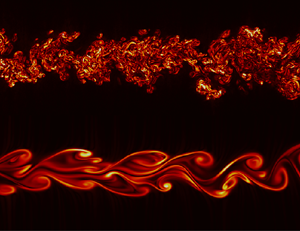Article contents
Turbulent planar wakes of viscoelastic fluids analysed by direct numerical simulations
Published online by Cambridge University Press: 08 August 2022
Abstract

Direct numerical simulations employing the finitely extensible nonlinear elastic constitutive model closed with Peterlin's approximation (FENE-P) are used to investigate the far-field region of turbulent planar wakes of viscoelastic fluids and to develop the theory describing these flows. The theoretical results display excellent agreement with the simulations and provide new scaling laws for the evolution of the shear layer thickness  $\delta (x) \sim x^{1/2}$, mean velocity deficit
$\delta (x) \sim x^{1/2}$, mean velocity deficit  ${\rm \Delta} U(x) \sim x^{-1/2}$ and, for very high Deborah numbers, of the maximum polymer shear stresses
${\rm \Delta} U(x) \sim x^{-1/2}$ and, for very high Deborah numbers, of the maximum polymer shear stresses  $\sigma ^{[p]}_c(x) \sim x^{-2}$ and averaged polymer chain extension
$\sigma ^{[p]}_c(x) \sim x^{-2}$ and averaged polymer chain extension  $\textrm {tr}(\bar {C}(x) - \boldsymbol{\mathsf{I}}) \sim x^{-2}$, where
$\textrm {tr}(\bar {C}(x) - \boldsymbol{\mathsf{I}}) \sim x^{-2}$, where  $x$ is the streamwise distance from the solid body generating the wake. The theory is able to show the existence of self-similarity for the profiles of mean velocity, mean polymer shear stress, averaged polymer chain extension and the conditions for similarity of the turbulent shear stress, and is very well supported by the numerical simulations. Similarly to the case of viscoelastic turbulent planar jets (Guimarães et al., J. Fluid Mech., vol. 899, 2020, p. A11), when the inlet Weissenberg and Deborah numbers are sufficiently large, turbulent viscoelastic wakes exhibit a considerable reduction of the spreading rate and of the normalised Reynolds stresses. However, for very large downstream locations the turbulent viscoelastic wake recovers the classical evolution laws observed for Newtonian turbulent planar wakes.
$x$ is the streamwise distance from the solid body generating the wake. The theory is able to show the existence of self-similarity for the profiles of mean velocity, mean polymer shear stress, averaged polymer chain extension and the conditions for similarity of the turbulent shear stress, and is very well supported by the numerical simulations. Similarly to the case of viscoelastic turbulent planar jets (Guimarães et al., J. Fluid Mech., vol. 899, 2020, p. A11), when the inlet Weissenberg and Deborah numbers are sufficiently large, turbulent viscoelastic wakes exhibit a considerable reduction of the spreading rate and of the normalised Reynolds stresses. However, for very large downstream locations the turbulent viscoelastic wake recovers the classical evolution laws observed for Newtonian turbulent planar wakes.
JFM classification
Information
- Type
- JFM Papers
- Information
- Copyright
- © The Author(s), 2022. Published by Cambridge University Press
References
REFERENCES
- 11
- Cited by


